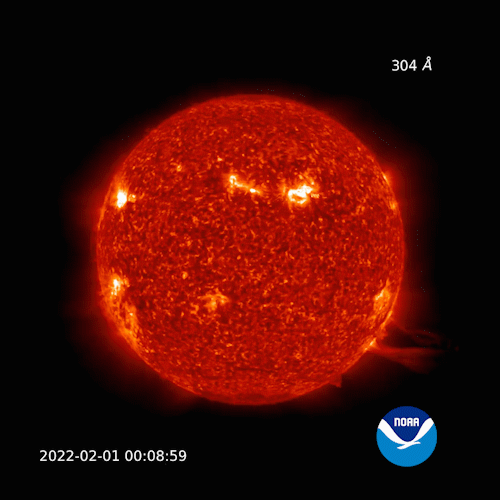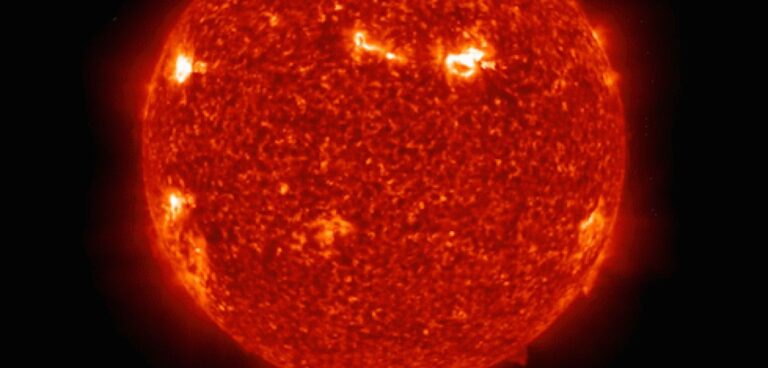A study, published in the American Geophysical Union’s journal Space Weather, has analyzed the space weather conditions that led to the loss of 38 Starlink satellites.
In early February 2022, 38 of the 49 Starlink satellites that SpaceX launched into very-low-Earth orbit burned up as a result of a period of prolonged, minor geomagnetic storm conditions. According to the researchers, the study highlights the need for better space weather observations and forecasts for the emerging commercial spacecraft industry.
Scientists from NOAA’s Space Weather Prediction Center (SWPC) and Cooperative Institute for Research in Environmental Sciences (CIRES) at the University of Colorado at Boulder worked closely with SpaceX Starlink to co-author this study. The organizations used observations from the Starlink satellites and forecasts and numerical simulations from NOAA to demonstrate the disturbance in the upper atmosphere and increased satellite drag conditions during the February event. NOAA’s GOES-16 satellite captured a series of M-class solar flares on February 1, 2022. These eruptions on the sun caused minor geomagnetic storms that destroyed 38 SpaceX Starlink satellites launched on February 3. This study therefore confirms SpaceX’s preliminary analysis – high satellite drag conditions reduced satellite stability and made the orbit-raising process impossible. In response, the satellites quickly deorbited and ultimately burned up during reentry into the Earth’s atmosphere.
SWPC forecasters predicted the minor to moderate geomagnetic storms and issued watch, warning, and alert products beginning January 30, 2022, and continued to do so through February 5. However, the center doesn’t currently have warnings and alerts for satellite drag or neutral density predictions as described in the study, but has since prioritized the importance of this service following the satellite loss event.
The study recommends accurate forecasts of low-Earth orbit events ahead of the onset of solar and geomagnetic storms and identifies that it is crucial for SWPC to establish suitable alerts and warnings based on neutral density predictions to provide users guidance for preventing satellite losses due to drag and to aid in collision avoidance calculations. To provide suitable space weather predictions and warnings for this expanding industry, SWPC therefore needs new observations and data to improve space weather forecast models.
The study identifies additional space weather forecast improvement services, and research areas that are critical to support the spacecraft industry at low-Earth orbits, such as better predictions of arrival time of coronal mass ejection and magnitude and duration of geomagnetic activity. In addition, establishing the uncertainties and variability of solar wind/near-Earth interactions should be prioritized to provide probability forecasts of the responses at Earth. It also recommended computationally efficient data-assimilation techniques, to use the large volume of on-orbit neutral density observations that will enable SWPC to improve neutral atmosphere nowcasts and produce better forecasts. Alongside these recommendations, the study highlighted the need to improve processes in the satellite industry to incorporate space weather information and neutral density models that better capture space weather responses into satellite design and operations. The study also noted that insufficient measurements between the sun and Earth, limitations in SWPC modeling tools and knowledge gaps in space physics all lead to prediction errors on geomagnetic storm timing and intensity.
The researchers found that SWPC’s physics-based numerical model, called Whole Atmosphere Model-Ionosphere Plasmasphere Electrodynamics (WAM-IPE), captured the increased neutral density environment responsible for the Starlink satellite loss event, out-performing the empirical model used by the Starlink team for their analyses. Collaborating with Starlink and others in this growing industry, SWPC will incorporate design changes to the WAM-IPE to make the model more useful to both industry and government interests in low- and very-low-Earth orbits. In addition, SWPC is developing a neutral density product with a comprehensive, satellite-focused webpage for the spacecraft industry to access model outputs and forecasts. These improvements will take place in mid-2023.
Further, the Starlink team has implemented system upgrades to ensure future low insertion missions can accommodate the satellite drag given the anticipated increase in solar and geomagnetic activity as we approach the maximum of Solar Cycle 25, the study said. SpaceX has completed more than 60 satellite launches since November 2019, specifically for deploying the Starlink system. The earlier launches took place during a period of quiet space weather conditions compared to what was observed in February 2022.
Tzu-Wei Fang, lead author of the study and space scientist at NOAA Space Weather Prediction Center, said, “This study demonstrates the benefits that can come from collaborative work between government and industry. The free exchange of model and satellite data and close interaction between SWPC and the Starlink team have enabled us to identify the quantitative impact of space weather events on these satellites, which help us to quickly prioritize our tasks to improve our space weather models and design the operational products that will better meet the needs of modern space commerce.”




